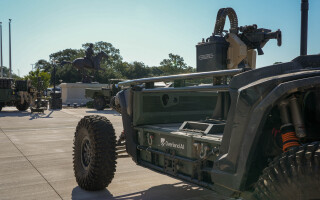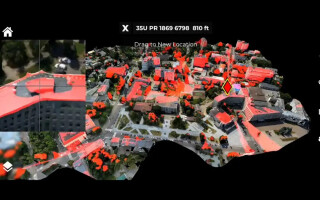LONDON -- DSEI UK 2025. Speaking with embedded computing suppliers at the DSEI 2025 show in London this week, I’m hearing growing support of requirements for open standards and open architectures, even if they don’t necessarily know about the U.S. Department of Defense (DoD) mandate for MOSA, or modular open systems approach, content.
Military Embedded Systems
Op-Eds
GUEST BLOG: Now a necessity -- Accelerating defense readiness through AI-enabled systems engineering - Blog
September 05, 2025The next generation of defense systems will not excel in modern warfare through hardware alone, but rather by how quickly and confidently we can design, validate, and deploy it. As mission complexity increases and multidomain coordination becomes the norm, traditional engineering approaches are unable to support today’s complex system of systems. The conflict in Ukraine has shown that using artificial intelligence (AI) in unmanned systems is a viable solution to reduce direct warfighter involvement while enhancing and increasing combat effectiveness.
GUEST BLOG: Sensor fusion at the tactical edge – Why GPUs are essential for modern C5ISR systems - Blog
September 05, 2025Modern C5ISR [command, control, communications, computers, cyber, intelligence, surveillance, and reconnaissance] platforms are only as effective as their ability to process and analyze the data gathered from sensors.
GIVING BACK: Warrior Canine Connection - Blog
September 03, 2025Each issue, the editorial staff of Military Embedded Systems will highlight a different organization that benefits the military, veterans, and their families. We are honored to cover the technology that protects those who protect us every day.
GUEST BLOG: Why MRAM matters more than ever for military embedded systems - Blog
September 03, 2025Processors, algorithms, and power constraints are frequently discussed in the military embedded systems arena. But memory is more than passive storage: Embedded systems for defense and aerospace applications need to react quickly, and the memory that keeps mission-critical work in motion doesn’t always get the credit it deserves.
GUEST BLOG: The supply-side of the worldwide military markets - Blog
August 01, 2025WARFARE EVOLUTION BLOG: Last time, we built the worldwide military market demand-side tree diagram. By now, you should have drawn that diagram and filled-in the roots and branches with the data revealed in the previous articles. This time, we will build the supply-side tree diagram and integrate the two. When we complete this task, don’t try to add-up the supply-side and demand-side numbers and expect them to balance or even come close. The market research reports mentioned count things differently, and they estimate lots of numbers. These people are not certified public accountants.
GIVING BACK: Carry The Load - Blog
July 31, 2025Each issue, the editorial staff of Military Embedded Systems will highlight a different organization that benefits the military, veterans, and their families. We are honored to cover the technology that protects those who protect us every day.
GUEST BLOG: Why 4U is for you - Blog
June 27, 2025The new VITA 100 suite of standards is shaping up to be an interesting display of computing system standards development. Built from years of experience, stemming from VME and OpenVPX, VITA 100 is drawing on the best of these earlier standards to craft a new standard that will enable suppliers and integrators to hit the ground running as soon as the documents are released.
GUEST BLOG: Achieving edge AI in space applications - Blog
June 27, 2025Processing demands in space environments continue to increase exponentially, with more in-orbit applications requiring that image and signal processing as well as networked communications functions be performed at the edge. This reality increases the importance of onboard data analysis, prioritization, and sharing in reliable space-rated systems.
GUEST BLOG: Enhancing GPS resilience, protecting national security and public safety - Blog
June 27, 2025This year, 2025, marks the 30th anniversary of the U.S. military’s announcement that the Global Positioning System (GPS) met all requirements for full operational capacity, a milestone that was formally announced by the U.S. Air Force Space Command on July 17, 1995. Three decades later, despite U.S. Department of Defense (DoD) challenges in modernizing the technology, GPS remains the principal source of position, navigation and timing (PNT) data for the U.S. military and its partners, continuously generating integral information for command, control, communications, computing, intelligence, and reconnaissance (C4ISR); targeting; and weapons delivery. Importantly, GPS is also continually relied upon in the commercial sector, especially in the public safety and security industry. Home-security companies routinely use GPS to route employees for service appointments, direct technicians and first responders to incidents, and provide mobile safety services to ride-sharing companies and their passengers. Maintaining these security and life-safety services is a critical aspect of U.S. national security.
GUEST BLOG: Safety in numbers – Standards-compliant multisensor detect-and-avoid - Blog
June 11, 2025We’ve listened to many customers describe the type of detect-and-avoid (DAA) needs they have for their concept of operations (ConOps), usually pausing to ask about their existing knowledge of DAA and generally hearing responses that are informed by “industry knowledge.” While most of the community working in the uncrewed aircraft systems (UAS) industry is well-informed, there are recurring themes that would benefit from the subtle distinction about what is – and importantly – what is not, DAA.
GIVING BACK: The Camaraderie Foundation - Blog
June 11, 2025Each issue, the editorial staff of Military Embedded Systems will highlight a different organization that benefits the military, veterans, and their families. We are honored to cover the technology that protects those who protect us every day.
GUEST BLOG: Smarter by design – How AI Is rewriting the rules of defense engineering - Blog
June 11, 2025Today’s defense and intelligence missions face a persistent challenge in that high-fidelity optics and sensor systems are expensive and slow to produce. The sector remains stuck in the size, weight, power, and cost (SWaP-C) dilemma, where engineering tradeoffs restrict performance, delay innovation, and increase costs. However, artificial intelligence (AI) can now be harnessed to model millions of design iterations in seconds, allowing for advances in materials such as metasurfaces and metalenses to be incorporated into exquisite optic and system systems helping to overcome traditional SWaP-C limitations.
GUEST BLOG: 5G – critical to modernizing federal IT - Blog
June 11, 2025The rapid expansion of 5G is transforming the Internet of Things (IoT), enabling greater integration of devices at the edge of the network. This advancement is particularly impactful for government applications, where 5G enhances national-security operations, improves military surveillance capabilities with drones, and enables faster and more secure data transmission for emergency response.
GUEST BLOG: Smarter, tougher networking – How AI can help in DDIL environments - Blog
June 11, 2025The aim of the U.S. Department of Defense (DoD) Combined Joint All-Domain Command and Control (CJADC2) is clear: to enable the military to make faster and better-informed decisions to achieve decision advantage over its adversaries. But the path to that goal is anything but straightforward.
-
High-performance rugged computing systems to be showcased by One Stop Systems at AUSA 2025
October 07, 2025
-
Tactical Grade, Six Degrees of Freedom IMU
October 07, 2025
-
Meet the FACE® Technical Standard with Qt for MOSA
October 06, 2025
-
FACE and SOSA Consortia Technical Interchange Meeting set for October 7 & 8
October 02, 2025
-
Roboteam Unveils Roboteam HUB: A Unified AI-Powered Platform for Command and Control of Autonomous Robotic Fleets
October 06, 2025
-
NASA, UMass Lowell team launch telescope to identify distant space objects
October 06, 2025
-
Counter-UAS system deployed across Denmark by Terma
October 03, 2025
-
AI-powered uncrewed flight under development by GE Aerospace, Merlin
September 30, 2025
-
AI, cyber, and C-UAS capabilities to be showcased by EarlyBirds at AUSA 2025
October 07, 2025
-
New Lower-Cost AI Embedded Solution Now Available
October 07, 2025
-
Generative AI tech by Ask Sage gets highlight at AUSA 2025
October 06, 2025
-
Dataminr expands agentic AI capabilities with Intel Agents for the physical world
September 29, 2025
-
Space Force domain-awareness and software-acquisition program gains operational acceptance
October 01, 2025
-
U.S. DoD, DTRA award large threat-reduction contract
September 18, 2025
-
Precise Systems acquires Mission Focused Systems
September 10, 2025
-
GUEST BLOG: Military SBOM adoption -- strengthening software supply-chain security
September 03, 2025


















